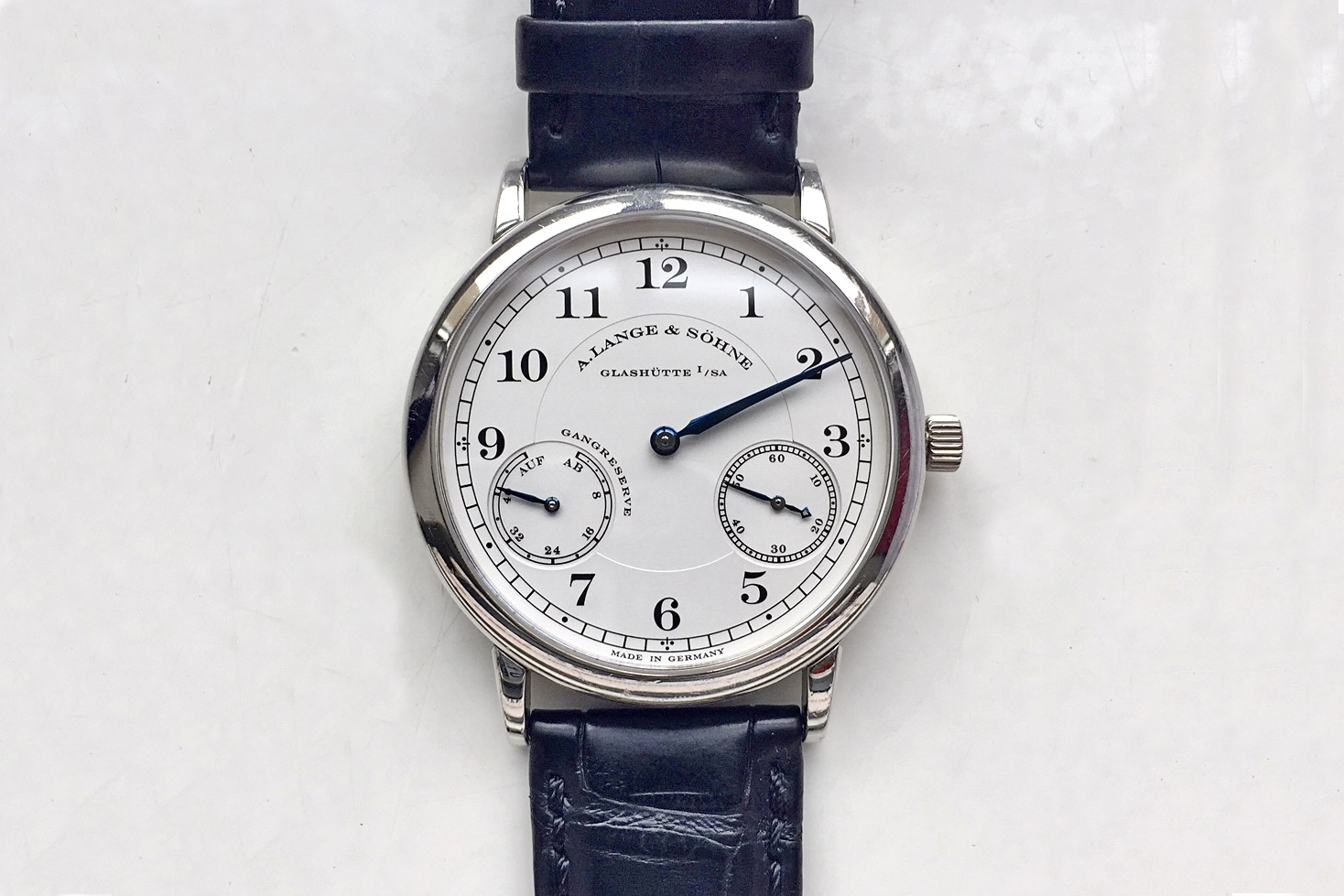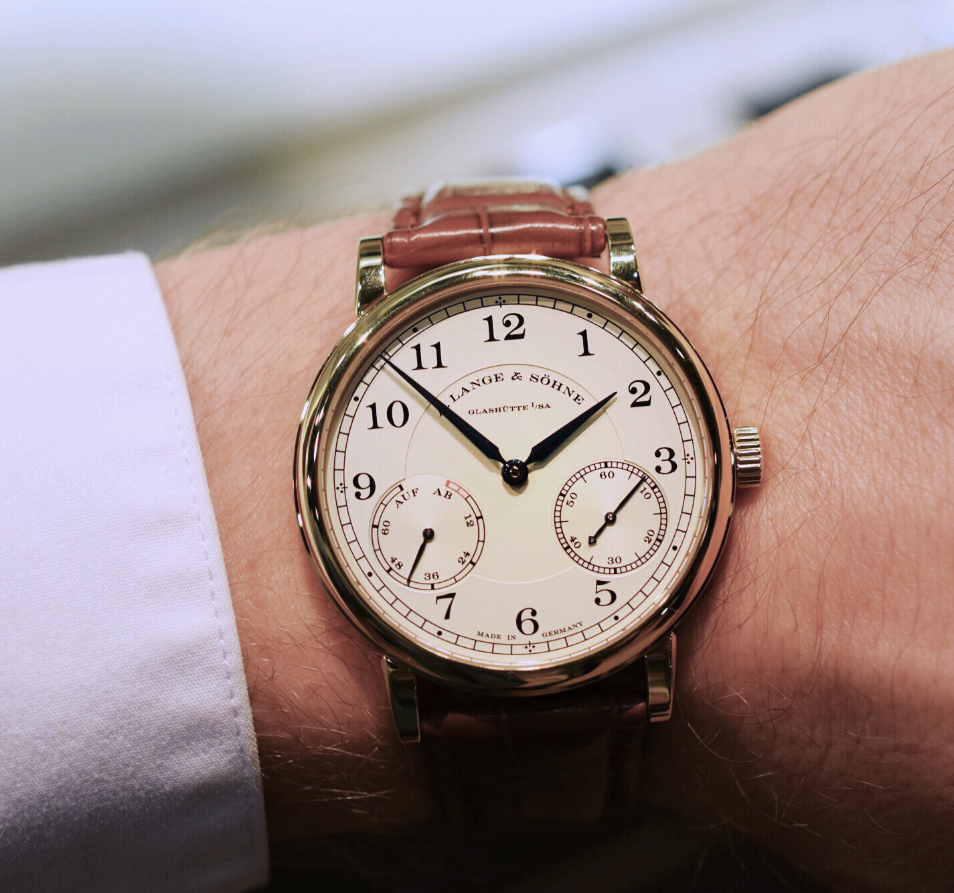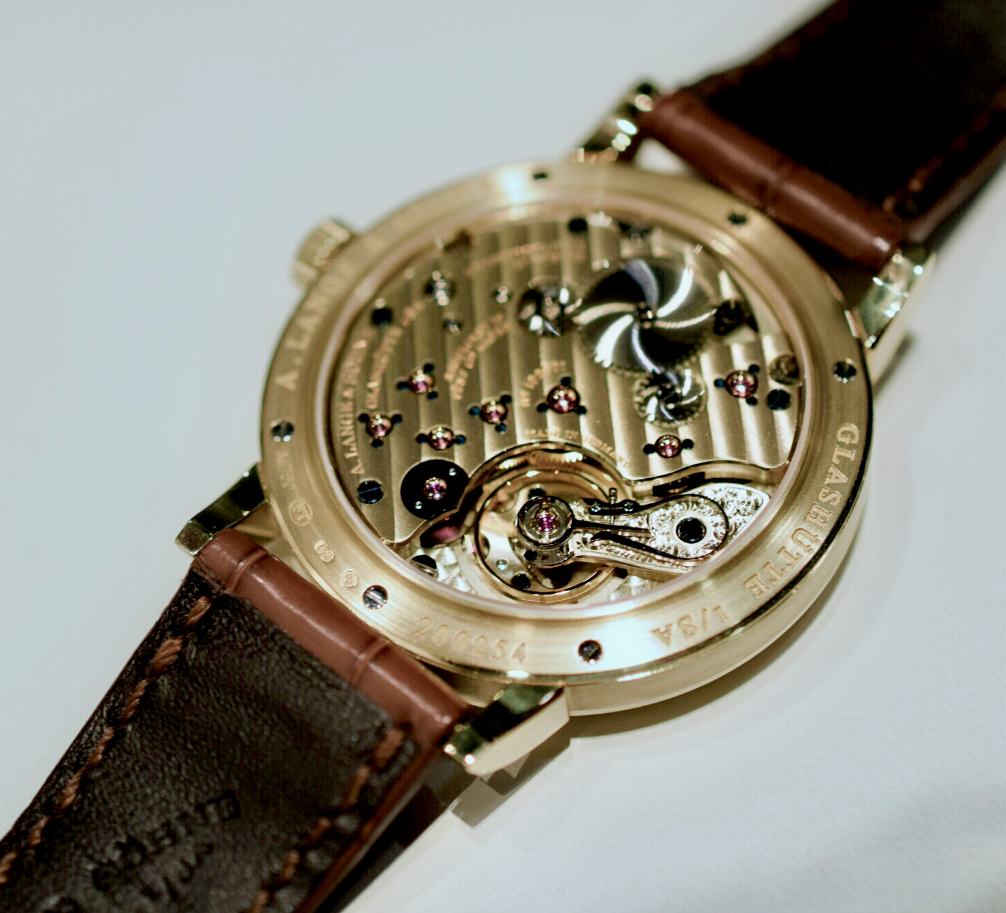This is the 39mm A. Lange & Sohne 1815 Up/Down. Coming to market in 2013, it was an overnight sensation. Elegant design. Classic complication. And attractive price point. Every Lange aficionado worth their salt wanted one. Making them very hard to come by in the early days. Now, almost a decade later, the 1815 Up/Down is still in the Lange collection. Unchanged. And as awesome as ever. Demand may have cooled a tad in the intervening years, but this watch still very much holds its own. Which got me thinking; what makes the Lange 1815 Up/Down such a good design? Keep reading and let’s see if we can figure it out together.
A (Very) Brief History Of The 1815 Collection
As I mentioned above, Lange debuted the current version of the 1815 Up/Down in 2013. And so that’s when most people assume the history of the model begins. But it actually dates back much earlier than that. Fifteen years earlier in fact.
Now, if you know your Lange history, you know the brand “re-emerged” in 1994. That was following an involuntary, 40-plus year hiatus brought about by World War II. And the ensuing Soviet occupation of Eastern Germany. Despite this, one man never gave up the dream of carrying on his great-grandfather’s legacy. And so, as soon as the Berlin Wall fell in November, 1989, Walter Lange made plans to do exactly that.
- The late, great Walter Lange.
A few months later, he teamed up with industry legend Günter Blümlein. Their shared vision was to build world class watches in Glashütte again. Before they could do that though, they needed to establish the Lange manufactory anew. With support from some well-placed friends in the industry, the duo made fast progress. A mere two years later, Lange Uhren GmbH filed its first patent in 1992. The now iconic outsize date. Inspired by the Five-Minute Clock of the Semper Opera House in Dresden.
Two years after that the company unveiled the first A. Lange & Söhne watches of the modern era. A monumental achievement all things considered. Among these four models was the exceptional Tourbillon Pour le Mérite. At the time, it was not part of the 1815 collection. Indeed, the first watch with the 1815 in its name appeared in Lange’s collection the following year in 1995. So named after the birth year of Lange’s founding father, Ferdinand Adolph Lange.
- The presentation of the first four models in 1994.
Look a little closer at the Tourbillon Pour le Mérite though and you can see the hallmarks of the 1815. The railway-track minute scale. The blued steel hands. The Arabic numeral hour markers. And, of course, the notable absence of the outsize date. This was the start of something beautiful.
Enter the 1815 Up/Down
In 1997, the 1815 Up/Down made its first appearance in the Lange catalogue. Sized for the time, the case measures 35.9 mms in diameter and a slender 7.9 mms in thickness. Dimensions that by today’s standards seem a touch on the small side. Although, this is changing. The popularity of the Tudor Black Bay 36 being a good, recent example.
The case of the 1815 Up/Down features a three-step construction. Case back, case band and bezel. Alternating polishing and brushing finishes give it a contemporary look. And make the case much more interesting to look at than it otherwise would be. It’s an early example of many of the subtle design choices that have come to define Lange. This is in large part thanks to the genius of Blümlein. He wanted the watches to stand out from their Swiss counterparts. But in understated ways that only true connoisseurs would appreciate.
- A gorgeous example of the original 36mm Lange 1815 Up/Down – here in a platinum case. Credit: Langepedia
The dial lay-out is simple and practical, yet at the same time attractive and elegant too. Not such an easy balance to strike. On the one hand, this is a no-nonsense watch that tells you the bare details. But it has a certain charm to it that is undeniable. Central hands show the hours and minutes. While running seconds appearing on the sub-dial at 4 o’clock. Across from this is Lange’s now famed Auf/Aub or UP/DOWN power-reserve indicator. And it is from this that the 1815 Up/Down takes its unusual name.
It’s a reference to one of the first patents Lange acquired, in 1879. Designed for pocket watches, the device detects whether the watch is wound up or wound down. Or in other words, how much power reserve is remaining before it runs out of power. This device was first used in historic pocket watches and marine chronometers. Today it’s an iconic feature of many Lange watches. And the original 1815 Up/Down was one of the first modern models to feature it.
The New 1815 Up/Down
As nice as the 35.9mm 1815 Up/Down is, the reality is that it was too small for mainstream consumption. Not that there’s anything mainstream about Lange. But still, the brand needed to broaden the appeal of this foundational model. And so, in 2013, it underwent a makeover of sorts.
- A live shot of the rose gold Lange 1815 Up/Down I took when the model first came out – in 2014!
The three step case grew to a more modern 39mm x 8.7mm high. Ideal dimensions, I would argue, for a modern dress watch. Although some Lange purists lamented the loss of the authenticity of the original. At launch it was available in white, yellow and red gold. Although Lange has since discontinued the – I assume – less popular yellow gold version.
In a move away from the more utilitarian feel of the original, the entire case shows a high shine polish. It’s more in line with the dress watch aesthetic but is not to everyone’s tastes. I myself would have preferred more contrast in the finishing. But it is by no means a deal breaker. And if anything, it draws more attention to the quality of the case’s construction. Another subtle tweak is the introduction of a stepped bezel. This is a subtle reference to the model’s pocket watch heritage. But it also does a good job of disguising the added thickness of the case.
It’s worth noting that the crown also seems more proportional to the case. I always felt that on the 35.9mm version the crown was a touch on the small side. It was passable with the smaller diameter and didn’t stand out as a glaring issue. But I imagine it would be tricky for people with bigger fingers to operate. Pulling out the crown, winding the watch and setting the time are silky smooth. Not that you would expect any less from Lange.
- A live shot of the rose gold Lange 1815 Up/Down I took when the model first came out – in 2014!
The super clean dial is hewn from argenté-plated solid silver. The countersunk center gives it a nice sense of depth. Further accentuated by the domed front sapphire crystal. It’s only a slight doming mind you. Not like some of the watches you see today where the crystal extends mm’s above the case. The 1815 Up/Down is a watch you can slide away under your cuff with ease.
At first glance the dial looks identical to the original. But there are some subtle changes. One that tends to stick in my craw is the decision to make the sub-dials larger. Of course, with the larger case size there is more dial real estate to take advantage of. Plus, it improves legibility. But now the sub-dials overlap the Arabic numerals at 7 and 5 o’clock. It’s the barest of kisses but it makes things feel a little more crowded. Likewise, the top of the sub-dials come all the way up to the mid-line of the dial now.
Minute nit-picking aside though, this is one gorgeous dial. It’s simple yet full of character and embodies the true spirit of Lange. All the subtle finishing touches are there. The frosted texture of the dial. Thick print that would look out of place on any other watch. Sword-shaped, blued hands, sans lume of course. And let’s not forget that single dash of red on the power reserve for a touch of contrast.
- A live shot of the rose gold Lange 1815 Up/Down I took when the model first came out – in 2014!
As is typical with Lange creations, the reverse of the 1815 Up/Down is even more of a head turner. Visible through a sapphire case back is the manual wind Calibre L051.2. It’s based on the caliber L051.1, the base calibre of the 1815 collection. But with some impressive upgrades. The most notable one is of course the increased power reserve.
At 72 hours this watch is weekend proof. Meaning you can take it off on Friday night and put it back on Monday morning without needing to wind it in-between. Another cool feature is that when the power reserve runs out, the seconds’ hand always stops at zero. Yet another example of Lange’s painstaking attention to detail. It’s also worth noting that the movement uses an in-house balance spring and wheel.
Finishing of the movement is of course top shelf. The plates are German silver – an alloy of copper, nickel, and zinc. This material is not treated, so over time the metal will oxidize, forming a nice patina. Lange doesn’t use its trademark three-quarter plate design here though. Instead the construction is more contemporary. With the ratchet wheel and click spring exposed for the first time on a model in the 1815 collection. All the other hallmarks of Lange are present though. The Glashutte ribbing. Chamfered and polished edges. Jewels set in polished gold chatons and secured by heat-treated blue screws. And let’s not forget the hand engraved balance cock, complete with floral motif.
The 1815 Up/Down comes on a supple leather strap, befitting of a classic dress watch.
Price & Availability
The A Lange & Sohne 1815 Up/Down retails for US$31,800. That’s in white or red gold. I’ve always had a soft spot for red gold version as it looks a bit warmer on the wrist. But either is a good option depending on your taste. You can also buy one pre-owned at a competitive price. This white gold model from WatchBox (affiliate link) comes in at a touch over US$25k.
Keep in mind this is not a watch that is likely to increase too much in value over time. In an ideal world that shouldn’t influence your decision but it’s always good to have all the facts. That said, the 1815 Up/Down is a fantastic entry point into Lange. And a great daily wear to boot.
What Makes The Design So Good?
The 1815 UP/DOWN has a certain ageless quality. Counting the original 36mm version, the design is now well over 20 years old. Yet, it looks as fresh as any model in the Lange line-up. And will no doubt remain popular with aficionados for years to come. Part of this is down to the clever use of white space on the dial. Resisting the urge to add more but ensuring everything you need is right there in front of you. Yet it’s also the strong character of the watch. This is unmistakable, not only as a German watch, but as a Lange.
There’s also the slim(ish) 39mm case that hugs the wrist and offers plenty of subtle details. It’s comfortable, it’s practical and also quite versatile. More so than you would expect. This is a watch where you can glance down at your wrist for a quick time check. Or get lost in all the subtle touches that make owning a Lange a pleasurable experience. Not bad for a time only model with a power reserve.
Technical Specifications: A. Lange & Sohne 1815 Up/Down
- Case: 39mm x 8.7mm height – 18k pink or white gold, polished – sapphire crystal on both sides.
- Dial: solid silver, argenté – polished fixed bezel – Arabic numerals – blued steel hands.
- Movement: L051.2 – manual-winding – single barrel – time-only – 72 hour power reserve with indicator.
- Bracelet: Leather strap with buckle.
- Price: USD 31,800.
This article by TheWatchLounge has been sponsored by our partner WatchBox.






Love the classic look but that price is absolute bonkers:)
Is the dial such a good design? Check out the 5 on the dial. Sometimes the top of the 5 is cut off by the sub-dial. Sometimes it’s not. Both the 5 and the 7 are pinched by the sub-dials. Why aren’t the sub-dials moved closer to the center of the watch to give the 5 and 7 more breathing room? Furthermore, the sub-dials should be centered equidistant between the 3 and 5 and the 7 and 9. Because A. Lange & Sohne is arguably, the greatest watchmaker in the world, the clipped 5 is not forgivable. Every detail matters.
Hi David, I think you make a fair point and I addressed this in the article as well. The larger sub-dials improve legibility but crowd the dial somewhat. I think that’s why many purist collectors would argue the first generation is the better design – at least from a dial perspective. Problem is the 36mm case is just too small for most. As for the positioning of the sub-dials I believe that has to do with the movement architecture itself.